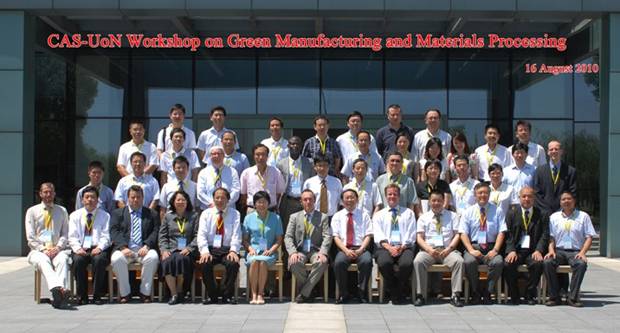Green Manufacturing and Material Processing Symposium
The Green Manufacturing and Material Processing Symposium was held in Ningbo at the Ningbo Institute of Material Technology and Engineering (NIMTE) on August 16, 2010. This symposium was organized by Chinese Academy of Sciences (CAS) and The University of Nottingham (UoN) in UK, and financially sponsored by Bureau of International Co-operation, CAS and Ningbo Science and Technology Bureau.
The symposium covered recent research progress in the fields of nano-technology, battery technology, green processing, etc. Prof. Ed Lester, the Director of Process and Environmental Research Division of UoN, introduced his patented continuous hydrothermal reactor technique which can be used to produce high-quality dispersed inorganic nano-particles through the control of particle size, distribution, morphology and composition. This technique can not only avoid inherent risks during dry powder handling but also limit agglomeration and aggregation problems occurred during nanocrystallization, and thus realize green processing of nanomaterials.
Prof. Kwang-Leong Choy of the Department of Mechanical, Materials and Manufacturing, Faculty of Engineering, UoN, described high-efficiency, low-cost, low-pollution and environment-friendly techniques for thin/thick film fabrication, where Electrostatic Spray Assisted Vapor Deposition (ESAVD) and Aerosol Assisted Ion Deposition (AAID) were emphasized for their bright future. ESAVD is an atomic deposition method and is able to produce super-pure nanostructured ceramics at low processing temperatures. This advanced method has been developed to produce a wide range of nanostructured thin films. AAID has been used to develope various nanostructured ceramic thin films. AAID has also been applied in the fabrication of thin/superthin polymer films and nanostructured composite coatings. Both ESAVD and AAID are general technologies for the fabrication of 2D and 3D environment-friendly coatings. The coating of nanostructured oxide and non-oxide using ESAVD and AAID is advantageous in both aspects of low cost and high performance.
Dr. L. Luke Xue from NIMTE and Dr. Tao Wu from UoN, Ningbo, discussed green processing technologies in the aspects of green processing and applications of polymers and bioenergy technology, respectively. Dr. Xue presented the research work carried out in his division, including development of bio-based and biodegradable polyestreramides, polymers related with renewable energy and advanced engineering plastics using shorter synthetic routes, lighter polymeric composites for energy-saving vehicles, advanced functional polymer membranes for high-efficiency gas water processing, polymers for health improvement, halogen-free flame retardants, and techniques for organic solvent usage reduction in processing and recycling of polymers.


